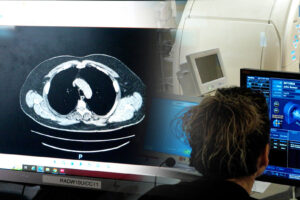Md. researchers hope virtual reality games can help spinal injury patients
Published 9/17/19 in the Daily Record
Tim Curtis, Daily Record Business Writer
Maryland Institute College of Art and the University of Maryland School of Medicine believe they can use virtual reality gaming as an alternative to medicine to help patients with high spinal cord injuries.

These patients, described as quadriplegic, have often just gone through the trauma that resulted in their injuries. They have difficulty moving their extremities or breathing without the aid of a ventilator.
“I think that technology designed for entertainment purposes has immense ability to heal. The cost of doing that kind of research is actually minimal as opposed to developing new pharmacologic,” said Sarah Murthi, an associate professor in the department of surgery at the University of Maryland School of Medicine. “Using virtual reality is just one way in which we can use technology not designed for medical applications in new and exciting ways.”
Murthi and the R Adams Cowley Shock Trauma Center are part of the Maryland Blended Reality Center. They worked with students in the MICA Game Lab to develop virtual reality games for spinal injury patients.
Murthi sees possibilities for helping patients learn to breathe without the help of a ventilator after they have experienced the trauma that caused their injuries. Often the high spinal cord injury severs the nerves to the diaphragm.
That means patients need to learn how to breathe again, Murthi said. That process takes a long time, and patients are often in the intensive care unit on a ventilator for at least six weeks to months.
“It’s a really stressful and terrible time,” Murthi said. “That process of weaning from the ventilator is also stressful.”
Patients transition from breathing tube inserted through the mouth to a tracheostomy — an opening created in the throat to insert the tube — early on. Then the patients are intermittently taken off ventilator for periods of time as they work to breathe on their own.
“Those trials are super stressful and elements of it can be painful, and the stress can make it harder for someone to breathe because they are so anxious,” Murthi said.
The most common tools to help with this process are medication, but Murthi believes that virtual reality games can help.
“What virtual reality can do is transport you to another world,” she said. “For periods of time it can put you in a different place where you can move.”
But the problem is that most virtual reality games are designed for people who can move. They are designed around the concept of being able to move while fully immersed in the came.
Games for quadriplegic patients need to be designed with the idea that they are mostly lying prone with limited movement, said Jason Corace, director of the game lab.
“How do you create a sense of immersion when someone is laid down and prone and can’t actually move their whole body,” he said.
The games instead use a QuadStick, a mouth-operated joystick.
Other adjustments have have been necessary as well.
The team worked with a patient, who advised them about some things they may not have thought of. For example, he reminded them that all of the controls needed to be used wearing a collar neck brace, Murthi said.
There can be a lot to learn by collaborating with patients who have already gone through the healing process, Murthi said.
The more researchers “listen to our patients after they’ve healed to understand better what we can do while they’re healing … we just don’t do that often,” she said.
MICA could use the experience here to explore other ways gaming can help patients. There have been talks with other institutions, like Johns Hopkins, as well, Corace said.
“It’s interesting for us to think about games as part of research, for play as part of research,” he said. “I think some of the work that we would like to see ourselves involved in is more work like this, which is games as part of a research project.”



